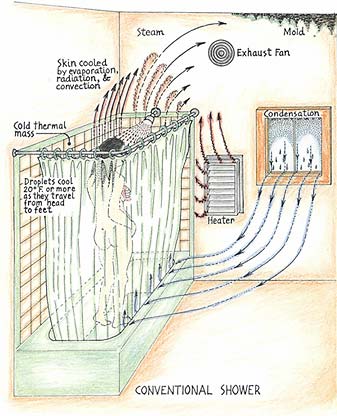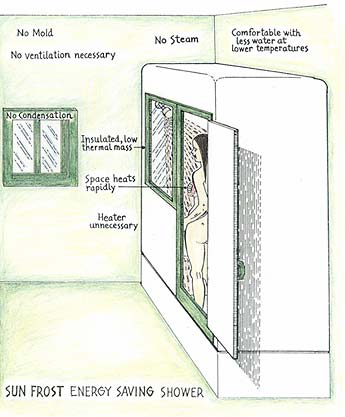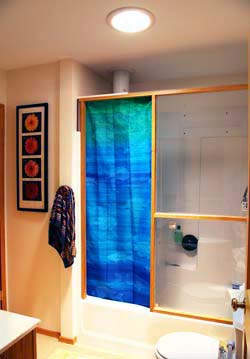Sun Frost Shower saves energy, water, and reduces a homes moisture load
 The
Problem The
Problem
The design features of a conventional shower
minimize thermal comfort, maximize energy use and water consumption while
exacerbating moisture problems. Most of these negative effects are caused
by evaporation. As small droplets of water fall from the shower head, the
high surface area and velocity of the particles of hot water experience
conditions, which maximize evaporative cooling of the droplets. Water
saving shower heads that produce exceptionally small water particles can
actually further increase evaporation. Water Particles can be cooled by
as much as 30ºF as they fall from the shower head to the ground. Evaporation
is also accelerated by convective air currents and low humidity. With
the shower curtain in place, a shower area can act as a thermal chimney.
Cold air enters from below the curtain; then rises as it is heated by
the walls of the shower stall, falling particles of hot water, and the
shower’s occupant. The humidity of the moving air is kept low by
condensing its moisture load on cold surfaces in the bathroom. This often
results in mold growth, rotting walls or ceilings, and wet insulation;
a problem that can be particularly acute in straw bale construction.
Bathroom moisture is often controlled
by the use of an exhaust fan. The fan sucks out the moisture-laden air,
which is then replaced by drier outside air. During the winter, the moisture
level in outside air is particularly low, further accelerating the rate
of evaporation. In addition, heat is required for the fan’s make
up air.
Evaporation is also the main source of heat loss from our skin. Lower
humidity will result in increased heat loss from the shower’s occupant
and require turning up the hot water to maintain comfortable conditions.
If a window is opened to control moisture, the temperature of the bathroom
will be lowered, the shower’s occupant will have to then turn up
the hot water to stay comfortable. Causing the bathroom to turn into a
steam room as moisture in the humid air leaving the shower condenses in
the cooler room air. The walls of a bathroom are often covered with high
thermal mass materials, such as ceramic tiles. The tiles will typically
be below skin temperature resulting in additional heat loss via radiation
and convection. The shower’s occupant will then again compensate
for this heat loss by turning up the hot water even further.
 The
Solution The
Solution
There is a simple solution to this myriad of related problems; preventing
airflow to and from the showing area is the key, in other words sealing
the shower stall. Additional benefits can be obtained by the incorporation
of insulated low thermal mass walls that heat up rapidly. The result is
a shower stall where air currents are minimized, humidity is increased
and the air is warmer. All these effects will increase thermal comfort
and reduce energy and water consumption. Another benefit is that with
the air in the shower warmed, the water vapor present will not be condensing
in the air, eliminating steamy conditions.
If the walls of the shower have a fairly low thermal
mass, the shower stall will heat up rapidly so a comfortable shower can
be taken even in an unheated bathroom. We constructed a shower stall for
Home Power magazine. The stall has very low thermal mass; the walls are
covered with “Reflectics” (aluminized bubble wrap). The top
of the shower is covered with a clear plastic bubble, see photo. The shower
is located in an unheated greenhouse. During the winter, when greenhouse
temperatures dip to 38ºF, you can still take a comfortable shower.
 A
fiberglass tub/shower combination in my home was sealed with plywood
and Plexiglas. This configuration allows for a comfortable shower
when the air in my bathroom dips to 50ºF. After showering, I can dry
off in the warmed up shower. A vent is opened in the ceiling to dry
off the interior. This arrangement allows me to take a comfortable
shower in a cold bathroom while using only 1/2 gallon of water per
minute. Many showers use a much as 3 gallons of water per minute. A
fiberglass tub/shower combination in my home was sealed with plywood
and Plexiglas. This configuration allows for a comfortable shower
when the air in my bathroom dips to 50ºF. After showering, I can dry
off in the warmed up shower. A vent is opened in the ceiling to dry
off the interior. This arrangement allows me to take a comfortable
shower in a cold bathroom while using only 1/2 gallon of water per
minute. Many showers use a much as 3 gallons of water per minute.
Application In Solar Homes And Developing Countries
This energy efficient shower combines effectively with solar heating,
since it allows for a fairly comfortable shower when water temperatures
dip to 90ºF (Typical water temperature for a shower is 105ºF). In tropical
countries showers are often unheated. The water is generally not quite
warm enough for a comfortable shower. To boost the temperature of the
water, an electrical heater located at the shower head is often used. The
sealed shower described here could move the water into the comfort zone
without using inefficient and costly electrical heating.
<<
Back to Concepts for Sustainable Living
|

